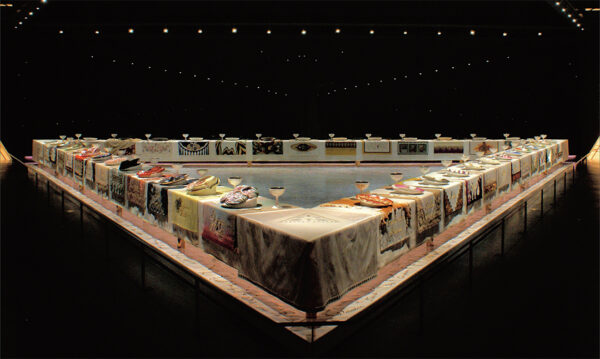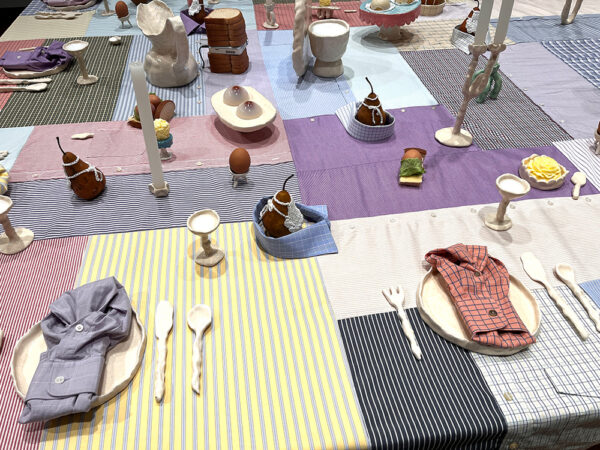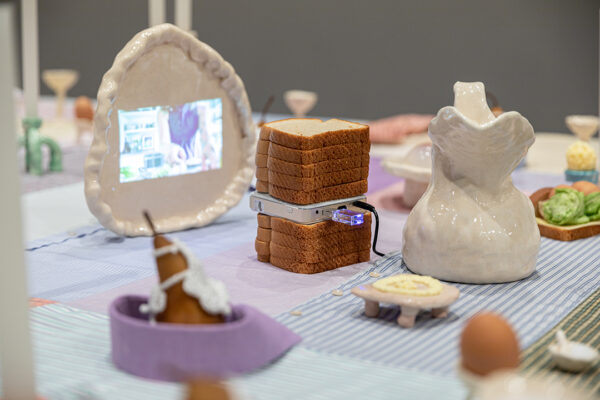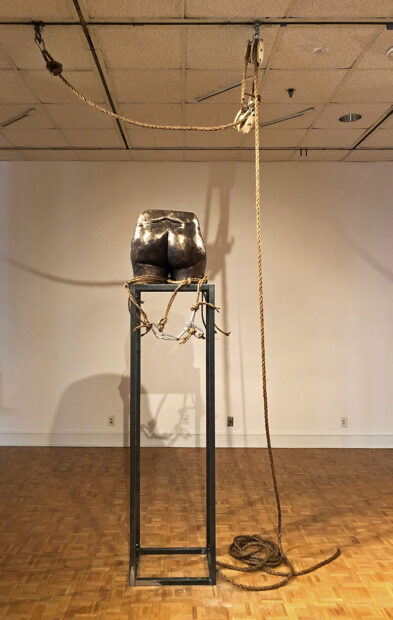Para leer este artículo en español, por favor vaya aquí. To read this article in Spanish, please go here.
Earlier this month, I had the opportunity to see third-year Texas Christian University MFA student Sheryl Anaya’s thesis exhibition, Let Things Taste of What They Are, at the Moudy Gallery. I was familiar with Anaya’s work from last year’s group show, With Pleasure, at TCU’s Fort Worth Contemporary Art gallery. That installation featured playful ceramic spoons, culturally-specific sculpted food, and other objects that spoke to domesticity, like embroidered napkins and a mango wallpaper vinyl. Anaya’s newest installation incorporates many of these same broad strokes, while narrowing into a cohesive singular, yet massive work. Though the piece is deeply rooted in a specific story, its overarching themes — traditional female roles, important historical female figures, performance art, and the female body — have a rich history throughout the art canon, and brought to mind other Dallas/Fort Worth artists whose work approaches similar topics.
At first glance, Let Things Taste of What They Are immediately conjures Judy Chicago’s The Dinner Party, an iconic work on permanent exhibition at the Brooklyn Museum of Art. The installations are both massive tables extravagantly set in a way that feels reverent and over the top. Chicago’s table forms a large open triangle, with each uniquely designed place setting dedicated to an important historical woman. By contrast, Anaya’s table is a filled-in rectangle with bench seating and place settings that, though individually unique because of their organic shapes, are all in the same style. Though Chicago’s piece is more solemn and Anaya’s more absurd, the use of the dinner party vernacular in both works alludes to traditional female roles of cooking, hosting, decorating, and craft.

Judy Chicago, “The Dinner Party,” 1974–79, mixed media: ceramic, porcelain, textile. Brooklyn Museum, Gift of the Elizabeth A. Sackler Foundation, 2002.10. © Judy Chicago. Photograph © Donald Woodman
Another key difference between the works is the absence of food on Chicago’s table and the abundance of it on Anaya’s. From pears wearing tiny knit aprons to gelatin molds with hot dog wieners placed at the center to look like breasts, Let Things Taste of What They Are is filled with food that references the female body. Anaya’s attention to detail is astounding; across the quilted tablecloth made from pastel work shirts, tiny sculpted butter flowers sit on white ceramic dishes and raw eggs are tucked into beds made of bread, cheese, and lettuce.
Anaya’s use of food in this elegantly constructed manner reminds me of fellow Fort Worth artist Sarah Ayala. Though Ayala works in a variety of formats, from large-scale murals to intricately decorated maps, she is also known for her brightly painted and sculpted cakes calling for women’s reproductive and economic rights. In a recent collaboration with Deryk Poynor, Cuntrol: A Lavish Socioeconomic Ecosystem Controlling the Underfunded, Ayala transformed a shipping container into a lush dinner party set-up. The dark wood table was filled with cakes, each with hand-lettered text. Some referenced amounts of money related to the Economic Impact Payments made by the government at the height of the COVID-19 pandemic; others referenced minimum wage and compared the pay gap between men and women. The phrase “Let Them Eat…” appeared on two of the cakes, alluding to the expression that has been attributed to Marie-Antoinette, the queen of France during the French Revolution.

Detail of work by Sarah Ayala in collaboration with Deryk Poynor: “Cuntrol: A Lavish Socioeconomic Ecosystem Controlling the Underfunded”
While Ayala’s cake’s references may be more accessible to the general public, the cakes seen throughout Anaya’s installation also relate to a historical female figure, though perhaps less known to a U.S. audience. With so much to see on Anaya’s table, it’s easy to miss the half-sphere cakes with a candied cherry on top, known as minne di Sant’ Agata or Saint Agatha’s Breasts. This Sicilian dessert references the tragic fate of a young pious woman who dedicated her life to God, taking a vow of celibacy. When she refused the advances of a Roman governor who wished to marry her, he had her imprisoned and tortured. The many abuses she endured included the governor’s call for her breasts to be cut off. She later died in prison. Now, Agatha is revered as the saint of breast cancer, rape victims, and wet nurses, and she has often been depicted in paintings carrying a platter holding her own breasts or breast-shaped foods.
Like Ayala, Anaya too uses the visuals of food to speak to the physical treatment of women’s bodies, but her work perhaps goes a step further by also spotlighting their objectification and consumption. Saint Agatha is believed to have lived from 231 to 251 AD, and yet her story echoes throughout history. Camouflaged on the table within Let Things Taste of What They Are are three video performance pieces. The small, square projectors are somewhat hidden in stacks of white bread, and each projects small videos onto the surface of white ceramic platter-like sculptures, which are leaned up against other small works. In one video, the artist wears an apron while she prepares a meal in a kitchen. All seems quite normal until the end, when she turns and reveals she is naked beneath her apron. In another video, Anaya bites a hole into a piece of lunch meat before placing it on top of her breast so that her nipple remains exposed. Each video adds to the absurdity of the work, but also can be seen as the artist reclaiming ownership of her body, deciding which parts to reveal and when.
The performance aspect of the installation, along with the concept of reclamation, relates back to Jer’Lisa Devezin’s 2019 Kiss My Ass performance, which took place at the Southern Methodist University Pollock Gallery as part of the artist’s MFA thesis exhibition. Though visually Devezin’s work is more minimal and severe than Anaya’s, both artists engage in restorative acts for specific historic women, and ultimately for themselves.
Devezin’s performance references Saartjie (Sarah) Baartman, an African woman born in 1789, who was fetishized and treated like an oddity for the entertainment of European society. Known derogatorily as the “Hottentot Venus,” Baartman was paraded and displayed at circuses so audiences could gawk at the shape of her body, specifically her buttocks. Even after her death, a plaster cast of her body, along with her brains and genitals, were displayed at the Musée de L’Homme (Museum of Mankind). Following his election as President of the Eastern Cape South Africa in 1994, Nelson Mandela requested the repatriation of her remains and the casting. The French government did not comply until March 2002, and her remains were buried in the Eastern Cape in August of that year.
During her performance, Devezin used a hoist to move a bronze cast of her own bottom up from cinder blocks sitting on the ground to atop a six-foot-tall pedestal. The action lasted just over ten minutes, and while most of the work was in the creation of a secure rope harness around the sculpture, the performance was still powerful and charged. Watching Devezin carefully secure and move the sculpture made me reflect on the care that we show art objects, compared to the violence with which Black bodies are too often treated. By the end, she had, in effect, uplifted and revalued the Black female body. The title of the work, too, uses a colloquial dismissive phrase as a call for respect.
Similarly, the title of Anaya’s installation repurposes a phrase from popular culture. A well-known quote by Alice Waters, the first woman named Best Chef in America by the James Beard Foundation, “Let things taste of what they are” was originally a call for simplicity in cooking to showcase the natural flavors of a food. Anaya uses the phrase to call out the absurdity of a dessert shaped like a woman’s breast, which itself commemorates a young woman who was brutalized. And, perhaps even more generally, Anaya is asking that society strip the pretense and reveal the harsh realities that shape our world.
Art is a reflection of the society from which it is birthed. Created nearly a decade after the publication of Betty Friedan’s The Feminine Mystique, Judy Chicago’s The Dinner Party honors over 1,000 women across history because the artist sought to celebrate important female figures and showcase the untold and underrepresented histories of women. For all of the excitement around Chicago’s piece, the major criticism of her work (and feminism at large) is the lack of inclusion of women of color and women whose sexual orientation, gender expression, mental or physical ability, or even nation of origin further complicate their personal experiences and struggles. It is particularly poignant, then, to see how female artists of color address universal themes related to women’s traditional roles and women’s treatment in society.
Nearly fifty years later, though much has changed in the U.S. regarding gender equality — since 1974, women can now have credit cards in their names, since 2014 a higher percentage of women are enrolled in higher education than men. But much has remained the same — between 2014 and 2020, femicide in the U.S. has increased by 24%. This is why, after decades, artwork addressing women’s place in and treatment by society is as prescient as ever.
Devezin’s and Anaya’s works, though depicting women who lived 1,500 years apart, retell stories of people who were treated as objects. Though women today surely have more rights and authority over their lives than women of the past, there’s an unescapable undercurrent of potential threat to our bodies — we walk with keys between our fingers, prepared to fight an attacker, and share our location with friends and family so they can find us should we go missing. Highlighting women’s historical mistreatment reveals the deep-seated nature of violence against them, helping to shine a light on the realities that women still face today, and providing an opportunity for female artists to make defiant statements about their rights to their own bodies.








1 comment
Really great piece. loved the comparison and contrasts to multiple exhibits. well-written and a great read!